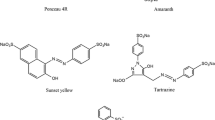Abstract
Systematic designed experiments were employed to find the optimum conditions for extraction of direct, reactive, and vat dyes from cotton fibers prior to forensic characterization. Automated microextractions were coupled with measurements of extraction efficiencies on a microplate reader UV–visible spectrophotometer to enable rapid screening of extraction efficiency as a function of solvent composition. Solvent extraction conditions were also developed to be compatible with subsequent forensic characterization of extracted dyes by capillary electrophoresis with UV–visible diode array detection. The capillary electrophoresis electrolyte successfully used in this work consists of 5 mM ammonium acetate in 40:60 acetonitrile–water at pH 9.3, with the addition of sodium dithionite reducing agent to facilitate analysis of vat dyes. The ultimate goal of these research efforts is enhanced discrimination of trace fiber evidence by analysis of extracted dyes.

Fitted absorbance response surface for extraction of a direct dye, C. I. yellow 58, using a ternary solvent system.








Similar content being viewed by others

References
Palenik S (1999) In: Robertson J, Grieve M (eds) Forensic examination of fibres, 2nd edn. Taylor & Francis, London, pp 364–378
Stoeffler SF (1996) J Forensic Sci 41:297–299
Rendle DF, Wiggins KG (1995) Forensic analysis of textile fibre dyes. Rev Prog Color Relat Top 25:29–34
Shore J (2002) Colorants and auxiliaries, vol. 1, 2nd edn. Society of Dyers and Colourists, West Yorkshire, England, pp 18–23
Laing DK, Dudley RJ, Hartshorne AW, Home JM, Rickard RA, Bennett DC (1991) Forensic Sci Int 50:23–35
Cheng J, Wanogho S, Watson ND, Caddy B (1991) J Forensic Sci 31:31–40
Home JM, Dudley RJ (1981) Forensic Sci Int 17:71–78
Sirén H, Sulkava R (1995) J Chromatogr A 717:149–155
Xu X, Leijenhorst H, Van den Hoven P, De Koeijer JA, Logtenberg H (2001) Sci Justice 41:93–105
Smith W (2005) Experimental design for formulation. Cambridge University Press, New York
Deming SN, Morgan SL (1993) Experimental design: a chemometric approach, 2nd edn. Elsevier Science, Amsterdam
Deming SN, Morgan SL (1979) Clin Chem 25:840–855
Vogh JW (1971) Anal Chem 43:1618–1623
Poiger T, Richardson SD, Baughman GL (2000) J Chromatogr A 886:259–270
Nalankilli G (1997) Colourage 44:33–39
Sheth GN (1990) Spectrochim Acta A 47:63–68
Tetler LW, Cooper PA, Carr CM (2005) Rapid Commun Mass Spectrom 8:179–182
Acknowledgments
This research was supported under a contract award from the Counterterrorism and Forensic Science Research unit of the Federal Bureau of Investigation’s Laboratory Division. Points of view in this document are those of the authors and do not necessarily represent the official position of the Federal Bureau of Investigation.
Author information
Authors and Affiliations
Corresponding author
Rights and permissions
About this article
Cite this article
Dockery, C.R., Stefan, A.R., Nieuwland, A.A. et al. Automated extraction of direct, reactive, and vat dyes from cellulosic fibers for forensic analysis by capillary electrophoresis. Anal Bioanal Chem 394, 2095–2103 (2009). https://doi.org/10.1007/s00216-009-2876-8
Received:
Revised:
Accepted:
Published:
Issue Date:
DOI: https://doi.org/10.1007/s00216-009-2876-8


